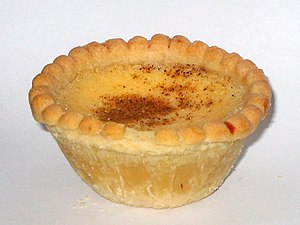Custard tart: Difference between revisions
→Portugal and Lusosphere: pastéis de nata are not custard tarts |
No edit summary |
||
| Line 38: | Line 38: | ||
No fruit, jam or decoration may be added. A light sprinkle of nutmeg<ref>{{cite web|title=Custard Tart|url=http://www.aussie-true-blue-recipes.com/CustardTart.html}}</ref> <ref>{{cite web|first=Bella|title=Custard Tart|url=http://www.bestrecipes.com.au/recipe/custard-tart-L371.html}}</ref> is mandatory. |
No fruit, jam or decoration may be added. A light sprinkle of nutmeg<ref>{{cite web|title=Custard Tart|url=http://www.aussie-true-blue-recipes.com/CustardTart.html}}</ref> <ref>{{cite web|first=Bella|title=Custard Tart|url=http://www.bestrecipes.com.au/recipe/custard-tart-L371.html}}</ref> is mandatory. |
||
===Brazil=== |
|||
Custard tarts weighing 260g are popular in Brazil. |
|||
===Hong Kong === |
===Hong Kong === |
||
Revision as of 14:47, 8 April 2014
 | |
| Type | Pastry |
|---|---|
| Main ingredients | Pastry crust, egg custard |
Custard tarts or flans pâtissier are a pastry consisting of an outer pastry crust filled with egg custard and baked.
History
The development of custard is so intimately connected with the custard tart or pie that the word itself comes from the old French croustade, meaning a kind of pie.[1] Some other names for varieties of custard tarts in the Middle Ages were doucettes and darioles. In 1399, the coronation banquet prepared for Henry IV included "doucettys".[2]
Medieval recipes generally included a shortcrust and puff pastry case filled with a mixture of cream, milk, or broth with eggs, sweeteners such as sugar or honey, and sometimes spices. Recipes existed as early as the fourteenth century that would still be recognisable as custard tarts today.[3] Tarts could also be prepared with almond milk during times of fasting such as Lent, though this was rather expensive and would have been popular only with the comparatively wealthy.[4] Often, savoury ingredients such as minced pork or beef marrow were also added (the combining of sweet and savoury ingredients was more common in medieval England), but unlike a modern quiche the custard filling itself was invariably sweet.[2]
Modern versions

Modern custard tarts are usually made from shortcrust pastry, eggs, sugar, milk or cream, and vanilla, sprinkled with nutmeg and baked. Unlike egg tarts, custard tarts are normally served at room temperature. They are available either as individual tarts, generally around 8 cm (3.1 in) across, or as larger tarts intended to be divided into several slices.
Britain and Commonwealth
Custard tarts have long been a favourite pastry in Britain and the Commonwealth. They are often called egg custard tarts or simply egg custards to distinguish the egg-based filling from the commonly served cornflour-based custards. They are sold in supermarkets and bakeries throughout the UK.[citation needed]
In Britain, the custard tart is regarded as a classic British dish, and as such a version by Marcus Wareing was selected on the BBC television program Great British Menu as the final course of a banquet to celebrate the Queen's 80th birthday.[5]
Variations on the classic recipe include the Manchester tart, where a layer of jam is spread on the pastry before the custard is added. Other versions may have some fresh fruit, such as rhubarb cooked into the filling.[6][dead link] Versions topped with elaborate arrangements of fruit show the influence of French pâtisserie.
Australia
The custard tart in Australia is legendary among cyclists as a reward for ascending a particularly steep mountain pass. It is simply called the Custard Tart.
No fruit, jam or decoration may be added. A light sprinkle of nutmeg[7] [8] is mandatory.
Brazil
Custard tarts weighing 260g are popular in Brazil.
Hong Kong
Custard tarts are popular in Hong Kong
France

Custard tarts (flans pâtissier) in France are generally larger and shallower than British ones. The filling may contain fruit, making it similar to a clafoutis.
Romania
See also
References
- ^ "Custard". Oxford English Dictionary, Second Edition. Oxford University Press. 1989. Retrieved 2007-12-14.
- ^ a b "Icon nominations > Egg custard tart". Icons — a portrait of England. Department for Culture, Media and Sport [1]. Retrieved 2007-12-14.
{{cite web}}: External link in|publisher= - ^ Matterer, James L. (2000). "Daryols". A Boke of Gode Cookery — Medieval Recipe Translations. Retrieved 2007-12-14.
- ^ "Baking for Britain — Custard Tarts". 2006. Retrieved 2007-12-15.
{{cite web}}:|first=missing|last=(help) - ^ "Great British Menu — The Winning Menu". 2006. Retrieved 2007-12-14.
- ^ Bird, Fiona. "Recipes: Rhubarb and custard tart". Masterchef. BBC. Retrieved 2008-01-17.
- ^ "Custard Tart".
- ^ "Custard Tart".
{{cite web}}:|first=missing|last=(help)
